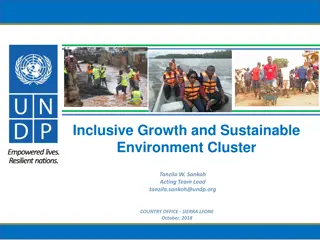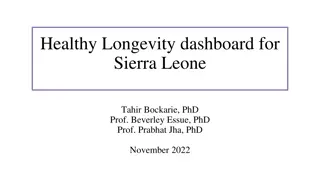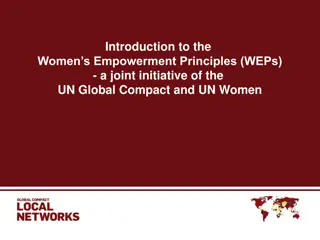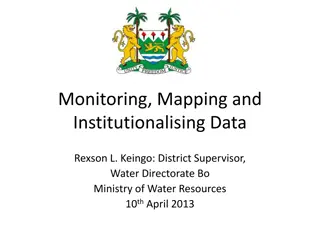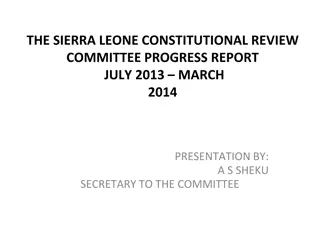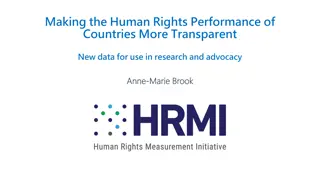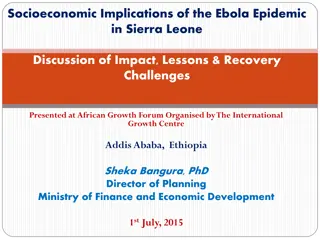
Economic Empowerment and Human Rights Initiatives in Sierra Leone
Indigenous non-governmental organization promoting women and children's rights, community development, and human rights in rural Sierra Leone. Focus areas include land rights, early child marriage, healthcare, and economic empowerment projects.
Uploaded on | 3 Views
Download Presentation

Please find below an Image/Link to download the presentation.
The content on the website is provided AS IS for your information and personal use only. It may not be sold, licensed, or shared on other websites without obtaining consent from the author. If you encounter any issues during the download, it is possible that the publisher has removed the file from their server.
You are allowed to download the files provided on this website for personal or commercial use, subject to the condition that they are used lawfully. All files are the property of their respective owners.
The content on the website is provided AS IS for your information and personal use only. It may not be sold, licensed, or shared on other websites without obtaining consent from the author.
E N D
Presentation Transcript
1 Annuities and longevity risk Lessons learnt from Japan and the work of the Asia Pacific Financial Forum (APFF) For ASSAL Annual Conference 2015 13 April, San Jose, Costa Rica Makoto (Mack) Okubo General Manager, International Affairs Nippon Life Insurance Company
2 Contents Rapid aging and demographic change in Japan and longevity risk 1 Fighting against low interest rate and negative spread problems 2 The work of Asia Pacific Financial Forum and the key issues identified 3 4 Conclusions Yin and Yang
3 Rapid aging Japan was in the lower-rankings until the 1980s, in the middle in the 1990s, and is already the highest in the early 21st century Percentage of 65 Years and Over Population (1950 - 2010) (%) 25 Japan Germany Italy France UK Canada US Russia Korea China Brasil India 20 15 10 5 0 1950 1955 1960 1965 1970 1975 1980 1985 1990 1995 2000 2005 2010 (Source: Statistic Bureau, Data is based on United Nations, "World Population Prospects," The 2010 Revision Note: Data for Japan is based on "Population Census of Japan )
4 Longer lifespan Japanese life expectancy is among the highest in the world. Many Japanese women live alone for around 10 years after their husbands pass away. (Year) M F Female Female Male Male Source: Ministry of Health, Labour and Welfare and National Institute of Population and Social Security Research ; courtesy of Swiss Re Japan.
5 Lower fertility rate - Trends in number of births Total fertility rate has dropped from 4.54 in 1947, to 1.91 in 1975, and to 1.26 in 2005 Baby Boomers reaching retirement age! 4.54 in 1947 3,000 5.00 Postwar baby boom [1947-49] 4.50 2,500 Second baby boom [1971-74] 4.00 Number of births (000s) Total Fertility Rate (%) 3.50 2,000 3.00 2.50 1,500 1.37 in 2008 2.00 1,000 1.91 in 1975 1.50 1.58 in 1966 1.00 500 1.26 in 2005 0.50 0 0.00 1950 1960 1990 2000 1970 1980 Year (Source: Ministry of Health, Labor and Welfare, Vital Statistics
6 Savings higher as age increases Savings per household by age in 2010 Savings are 2.7 million yen for a householder under age 30 8.5 times larger at 23.14 million yen for a householder age 60 or older Liabilities to be higher as age increases up to the ages 40 to 49, at which age they peak and begin to decrease (million yen) 2,500 2,000 1,500 Savings Liabilities Yearly income 1,000 500 0 29 30 39 40 49 50 59 60 69 70 (Source: Annual report on the family income and expenditure survey. Income and expenditure, Statistics Bureau, Ministry of Internal Affairs and communications 2010 )
7 Annuities/pension system in Japan and longevity risk The public pension provides a whole life annuity and the corporate pension provides a supplement in the form of a lump sum retirement payment or fixed-term annuity Longevity risk is mainly borne by government, employers, and individuals. Life insurers are subject to longevity risk, in case where the option for whole life annuity is chosen by policyholders for self-private pension. Offsetting longevity risk and mortality risk, Japanese life insurers exposure to longevity risk is limited, although gradually increasing Pension system Typical form of payment Other features National Pension whole life annuity - Employees Pension Insurance whole life annuity survivor s pension lump-sum retirement allowance or fixed-term annuity Corporate Pension some companies provide whole life annuities with a guaranteed term options for whole life annuity with guaranteed term and lump-sum are available Self-Private Pension fixed-term annuity (Source: Ministry of Health, Labor and Welfare)
8 Contents Rapid aging and demographic change in Japan and longevity risk 1 Fighting against low interest rate and negative spread problems 2 The work of Asia Pacific Financial Forum and the key issues identified 3 4 Conclusions Yin and Yang
9 Japan experienced a low interest rate environment Low interest rates becoming a worldwide trend Governement / Treasury Bonds 10 year Interest Rate 14 Japan Germany United Kingdom United States 12 10 8 6 4 2 0 1989/01/01 1991/01/01 1993/01/01 1995/01/01 1997/01/01 1999/01/01 2001/01/01 2003/01/01 2005/01/01 2007/01/01 2009/01/01 2011/01/01
10 Stock market has been also disappointing Low interest rate coincided with poorly-performing stock prices 38,915(Dec.29. 89) 8.220%(Sep. 90) \45,000 9.0 10year JGB \40,000 8.0 \35,000 7.0 \30,000 6.0 \25,000 5.0 \20,000 4.0 \15,000 3.0 Nikkei225 index \10,000 2.0 \5,000 1.0 7,054(Mar.10. 09) 0.540%(May. 03) \0 0.0 '89 '90 '91 '92 '93 '94 '95 '96 '97 '98 '99 '00 '01 '02 '03 '04 '05 '06 '07 '08
11 Negative spread problems in 1990s After the collapse of the bubble economy, Japan experienced a long-lasting, severe investment environment with low interest rates and poor performing stock prices. This, combined with a market dominated by long- term insurance products with high guaranteed returns, led to negative spread problems in the mid 1990s, although most Japanese life insurers endured the severe business environment. 10-year Interest Rate in Japan 10 10- -year Interest Rate in Japan year Interest Rate in Japan Bubble Economy Bubble Economy 10% 7.79% (October, 1990) 5% 0.81% (June, 2012) 0.83% (October, 1998) 0% 1970 1970 1980 1980 1 1990 1990 2000 2000 2010 2010 2 3 Positive spread Negative spread Positive or Negative Spread 1 2 3
12 Contents Rapid aging and demographic change in Japan and longevity risk 1 Fighting against low interest rate and negative spread problems 2 The work of Asia Pacific Financial Forum and the key issues identified 3 4 Conclusions Yin and Yang
13 APFF (Asia Pacific Financial Forum) APFF: Public-private collaboration in developing financial systems Importance of regional public-private collaboration: Legal and regulatory frameworks Financial market infrastructure Financial market integration APFF: informal, inclusive and advisory public-private platform for collaboration in the development of common strategies for developing sound, efficient and integrated Asia-Pacific financial markets Governments and regulatory bodies Private sector International organizations (IFIs, SSBs, others)
14 APFF Interim Report 12 Action Plans 1) A pathfinder initiative to develop credit information sharing systems 2) A pathfinder initiative to improve the legal and institutional architecture for security interest creation, perfection and enforcement and related workshops 3) Dialogues on regulatory issues in trade and supply chain finance 4) Workshops on emerging facilitators of trade and supply chain finance 5) A pathfinder initiative to develop classic repo markets 6) Workshops to develop strategies to improve legal and documentation infrastructure for the development of OTC derivative market 7) Self-assessment templates on information for capital market investors 8) ARFP (Asian Region Funds Passport) support initiative 9) Workshop series to develop an enabling Asia-Pacific securities investment ecosystem 10)Dialogue series on regulation and accounting issues impacting the long-term business of the insurance industry in Asia Pacific economies and longevity solutions 11)Collaboration with APEC Finance Ministers Process in promoting long-term investment, including infrastructure 12) Conference and workshop series on linkages on structural issues
15 APFF Insurance and Retirement Income Work Stream A holistic framework to support the long-term roles of insurance and pension industry in the Asia-Pacific Social security Financial Stability Financial inclusion Sustainable development Macro economy Insurance protection Insurance and pension Insurance industry industry Regulation and accounting Capital market and long-term investment Retirement Income and Longevity Solutions Microinsurance and disaster risk financing
16 Composition of the workstream Participants include experts from the insurance, pensions and financial industries, academic specialists and policymakers and regulators Participants (as of March 31, 2015): Nippon Life (Sherpa), Jardine Matheson (Vice Sherpa), ADB, AIA Group, ASEAN Insurance Council/WanaArtha Life, ASEAN Secretariat, Asociaci n de Aseguradores de Chile, Association of Insurance Supervisory Authorities of Developing Countries/Association of Insurers and Reinsurers of Developing Countries, Australian APEC Study Centre at RMIT University, Australian Super, Australian Treasury, Barnert Global(regulatory and micro-insurance), Canadian Pension Plan Investment Board Asia, Cathay Life, Citigroup(retirement income), , Great Eastern Life, HK-APEC Trade Policy Study Group, Hong Kong University of Science and Technology, IAG, ING Bank Singapore, International Insurance Society(special advisor), J.P. Morgan Asset Management Global Real Assets, Life Insurance Association of Malaysia, Manulife, MetLife(capital market), Nomura Securities(APFF coordinator) , OECD, OJK Indonesia, Oliver Wyman, PIMCO, Pramerica Financial Asia(longevity solution), Prudential Corporation Asia, RFPI Asia, RGA, Samsung Life (accounting, and liaison with AOSSG), Sun Life Financial, Tokio Marine(disaster risk financing), ASIFMA (observer and liaison with other relevant workstreams)
17 Retirement income and ongevity solutions The work on retirement income and longevity solution will focus on demand- and supply-side issues in the development of lifetime retirement income solutions Figure: Interrelated Issues in Promoting Retirement Security and Longevity Solutions 1 Governments facing a retirement tsunami 2 Existing market not adequate 3 Insurance industry can help 4 5 Stimulate demand Stimulate Supply Consumer education 6 Long term investments & Capital markets Tax incentive Innovative products Increase supply Reduce regulatory and accounting hurdles Wider investment universe 7 Multi-currency flexibility Regulation and accounting Capital market derivatives 8 Longevity solutions Capital Market Hedging
Regulatory issues Economic-based regime should have a long-term vision If a short-term-minded economic regime were implemented Significant volatility for long term products Driven to transfer risks over to customers Refrain from investing in non-fixed income assets Source APEC Seattle) Photo Santiago, Chile) Unintended consequences might occur if banking regulations were copied for insurers Insurers play an important role as long term investors Life insurers play an increasing role in the social security system Diversity needed to support a sound development of the environment Photo Sydney, Australia) 18
Regulatory issues (cont.) One-size-fits-all models would not work Consumers risk preference Expected roles of the insurers State of development of financial markets Protection-type products Investment-type products Mortality risk Longevity risk 19
20 Accounting issues Volatility in the balance sheet Short-term fluctuation should be avoided Assets-liabilities interaction should be reflected for a wide range of products sold in the region Discount rate should reflect the business model Volatility in the income statement The (optional) use of OCI for insurance liabilities and corresponding assets The proposed IFRS contains other significant issues for traditional long-duration products Complexity Consistency Transition requirements Presentation Photo Buenos Aires, Argentina)
21 Market and operational Issues Market issues Underdeveloped long-term capital market Small number of bankable projects available Lack of infrastructure financial instruments Lack of market instruments (i.e. derivative, hedging tools) to manage portfolio risk Constraints on long-term insurance business (both demand side and supply side) Operational issues Weakness in credit rating Lack of experience Uncertainty in legal framework (i.e. creditors rights, resolution) Collaboration with Capital market/FMI/PPP work is the key Photo Auckland, New Zealand)
22 Contents Rapid aging and demographic change in Japan and longevity risk 1 Fighting against low interest rate and negative spread problems 2 The work of Asia Pacific Financial Forum and the key issues identified 3 4 Conclusions Yin and Yang
23 Conclusion: yin and yang Some words from Taoism Be aware that the world is cyclical Don t go to the extreme, otherwise you will fall Bring the balance of yin and yang to the universe In order to manage the world, you should control yourself In order to implement international standards, you should first know your own country Photo Tao Garden, Chang Mai, Thailand)
24 Asia Pacific Financial Forum (APFF) Insurance and Retirement Income Work Stream For more details on the APFF, visit mackglobe.com or email Makoto Okubo, Nippon Life (m-okubo@nliinter.com)





